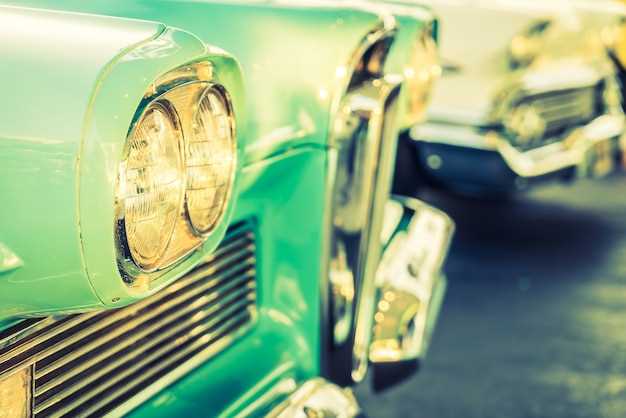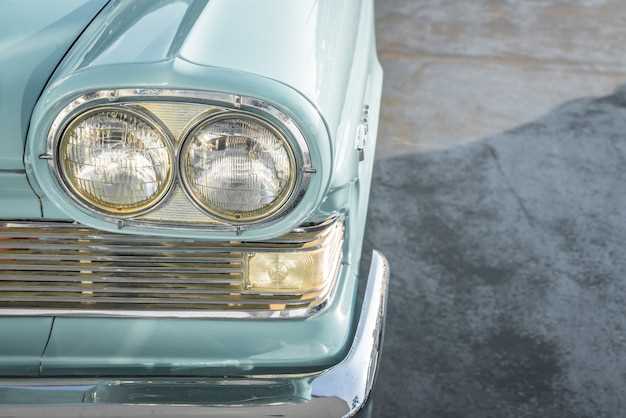New Trends in Classic Car Customization

The world of classic car customization has evolved dramatically over the years, merging timeless designs with cutting-edge technology. As automotive enthusiasts seek to express their individuality and enhance performance, innovative approaches to customization have emerged, redefining what it means to personalize a classic vehicle.
One of the most notable trends in customization is the integration of modern engineering solutions with vintage aesthetics. By incorporating lightweight materials, advanced suspension systems, and electric drivetrains, classic car owners are not only upgrading performance but also ensuring sustainability. Customization now encompasses a holistic approach where functionality meets style, offering a driving experience that is both exhilarating and environmentally conscious.
Moreover, the rise of digital tools and platforms has revolutionized the customization process. From computer-aided design (CAD) software to online communities that share ideas and resources, enthusiasts can now access a wealth of information that empowers them to take creative liberties with their projects. Customization is no longer limited to physical alterations; it includes a collaborative spirit that drives innovation and creativity within the classic car community.
Utilizing Modern Technology for Enhanced Performance
In the realm of classic car customization, integrating modern technology has become a pivotal trend that significantly enhances performance. One of the most noteworthy advancements is the implementation of electronic fuel injection (EFI) systems. These systems replace outdated carburetors, optimizing fuel delivery and ensuring more precise combustion. This transition not only improves engine efficiency but also maximizes horsepower and torque, which is essential for demanding driving conditions.
Another key area of development is the introduction of lightweight materials in car construction. Utilizing advanced composites and aluminum alloys reduces overall weight, leading to improved acceleration and handling. This trend allows classic car enthusiasts to maintain the vintage aesthetic while benefiting from the performance advantages of modern engineering.
Moreover, the installation of modern braking systems, such as anti-lock braking systems (ABS) and electronic stability control (ESC), offers enhanced safety and control. These features, traditionally absent in classic vehicles, provide drivers with increased confidence and responsiveness on various road surfaces.
The integration of smart technology through vehicle management systems has also gained traction. These systems monitor engine diagnostics, optimize performance settings, and even facilitate remote tuning. This capability allows car owners to tailor their vehicles to specific driving conditions or personal preferences, delivering a personalized driving experience.
Finally, hybrid and electric powertrains are emerging as revolutionary trends in the customization of classic cars. By merging traditional design with cutting-edge electric technology, enthusiasts are creating vehicles that honor the past while embracing sustainable practices. This shift not only reduces emissions but also opens up a new realm of performance potential, making classic cars more relevant in today’s environmentally conscious landscape.
Sustainable Materials and Eco-Friendly Customization Trends

Sustainable materials and eco-friendly practices are gaining traction in the classic car customization scene, reflecting a growing awareness of environmental issues. Customization using renewable resources not only preserves the integrity of vintage vehicles but also contributes positively to the ecosystem.
One prominent trend is the use of recycled materials in the construction and restoration of custom interiors. Upholstery made from recycled plastics and natural fabrics, such as organic cotton or hemp, provides an eco-friendly alternative to traditional leather and synthetic options. These materials not only reduce waste but also offer unique aesthetics and comfort.
Another innovative approach is the implementation of bio-based composites. These materials, derived from natural plant fibers and bio-resins, are proving to be lightweight yet sturdy, making them perfect for various customization applications, including body panels and trim. By choosing bio-composites, customizers can lower the carbon footprint associated with traditional manufacturing processes.
Additionally, electric and hybrid powertrains are becoming more popular among classic car enthusiasts looking to customize their vehicles while reducing emissions. Converting classic cars to electric power not only ensures a smaller environmental impact but also enhances the performance and efficiency of these timeless machines.
The pursuit of sustainability also extends to paint and coatings. Water-based paints, free from harmful solvents, reduce toxic emissions during both application and drying processes. These environmentally friendly paints come in various colors and finishes, allowing for creative expression without compromising ecological integrity.
In conclusion, the integration of sustainable materials and eco-friendly techniques in classic car customization is reshaping the industry. As car enthusiasts increasingly prioritize environmental responsibility, innovative approaches that balance tradition with modern sustainability will continue to define the future of automotive customization.
Personalized Aesthetics: Integrating Unique Design Elements

In the world of classic car customization, personalized aesthetics have become a prominent trend that allows car enthusiasts to express their individuality. Integrating unique design elements not only enhances the vehicle’s appearance but also influences its overall character and appeal. To achieve this, various innovative approaches can be employed.
One popular method is the use of custom paint jobs. These may include vibrant colors, intricate patterns, or even digital prints that reflect the owner’s personality and interests. Utilizing high-quality finishes and specialized techniques, such as airbrushing or hydro dipping, can create eye-catching designs that stand out at car shows and on the road.
Additionally, the incorporation of bespoke bodywork is gaining momentum. Body kits can be tailored to blend classic lines with modern aesthetics, giving vehicles a unique silhouette. Integrating materials like carbon fiber or aluminum not only adds a contemporary touch but also improves performance through weight reduction.
Another trend involves modifying interior elements, transforming the cabin into a personalized sanctuary. Upholstery can be customized using luxurious materials, unique stitching patterns, and specialized colors to match the exterior. Furthermore, incorporating modern technology, such as touch-screen displays or custom sound systems, enhances both functionality and comfort while retaining a classic vibe.
Emphasizing uniqueness also extends to wheel designs. Custom wheels in distinct shapes, finishes, or with engraved details can dramatically alter a classic car’s stance and style. This customization plays a crucial role in differentiating vehicles from one another, making each car a one-of-a-kind masterpiece.
Ultimately, personalization in classic car customization celebrates individual expression. By integrating unique design elements, enthusiasts not only preserve the essence of vintage vehicles but also transform them into personalized works of art that reflect their identity and passion for automotive history.



